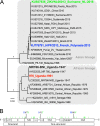Phenotypic Differences between Asian and African Lineage Zika Viruses in Human Neural Progenitor Cells
- PMID: 28815211
- PMCID: PMC5555676
- DOI: 10.1128/mSphere.00292-17
Phenotypic Differences between Asian and African Lineage Zika Viruses in Human Neural Progenitor Cells
Abstract
Recent Zika virus (ZIKV) infections have been associated with a range of neurological complications, in particular congenital microcephaly. Human neural progenitor cells (hNPCs) are thought to play an important role in the pathogenesis of microcephaly, and experimental ZIKV infection of hNPCs has been shown to induce cell death. However, the infection efficiency and rate of cell death have varied between studies, which might be related to intrinsic differences between African and Asian lineage ZIKV strains. Therefore, we determined the replication kinetics, including infection efficiency, burst size, and ability to induce cell death, of two Asian and two African ZIKV strains. African ZIKV strains replicated to higher titers in Vero cells, human glioblastoma (U87MG) cells, human neuroblastoma (SK-N-SH) cells, and hNPCs than Asian ZIKV strains. Furthermore, infection with Asian ZIKV strains did not result in significant cell death early after infection, whereas infection with African ZIKV strains resulted in high percentages of cell death in hNPCs. The differences between African and Asian lineage ZIKV strains highlight the importance of including relevant ZIKV strains to study the pathogenesis of congenital microcephaly and caution against extrapolation of experimental data obtained using historical African ZIKV strains to the current outbreak. Finally, the fact that Asian ZIKV strains infect only a minority of cells with a relatively low burst size together with the lack of early cell death induction might contribute to its ability to cause chronic infections within the central nervous system (CNS). IMPORTANCE The mechanism by which ZIKV causes a range of neurological complications, especially congenital microcephaly, is not well understood. The fact that congenital microcephaly is associated with Asian lineage ZIKV strains raises the question of why this was not discovered earlier. One possible explanation is that Asian and African ZIKV strains differ in their abilities to infect cells of the CNS and to cause neurodevelopmental problems. Here, we show that Asian ZIKV strains infect and induce cell death in human neural progenitor cells-which are important target cells in the development of congenital microcephaly-less efficiently than African ZIKV strains. These features of Asian ZIKV strains likely contribute to their ability to cause chronic infections, often observed in congenital microcephaly cases. It is therefore likely that phenotypic differences between ZIKV strains could be, at least in part, responsible for the ability of Asian ZIKV strains to cause congenital microcephaly.
Keywords: African strains; Asian strains; Zika virus; cell death; growth kinetics; human neural progenitor cells; neuronal cells; one-step growth curve; pathogenesis; phenotype.
Figures




References
LinkOut - more resources
Full Text Sources
Other Literature Sources
